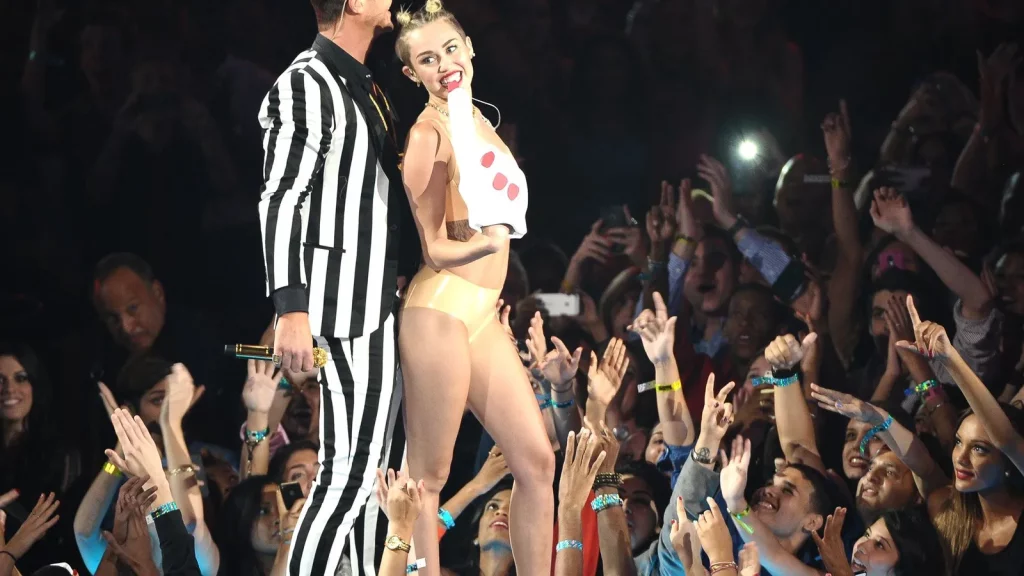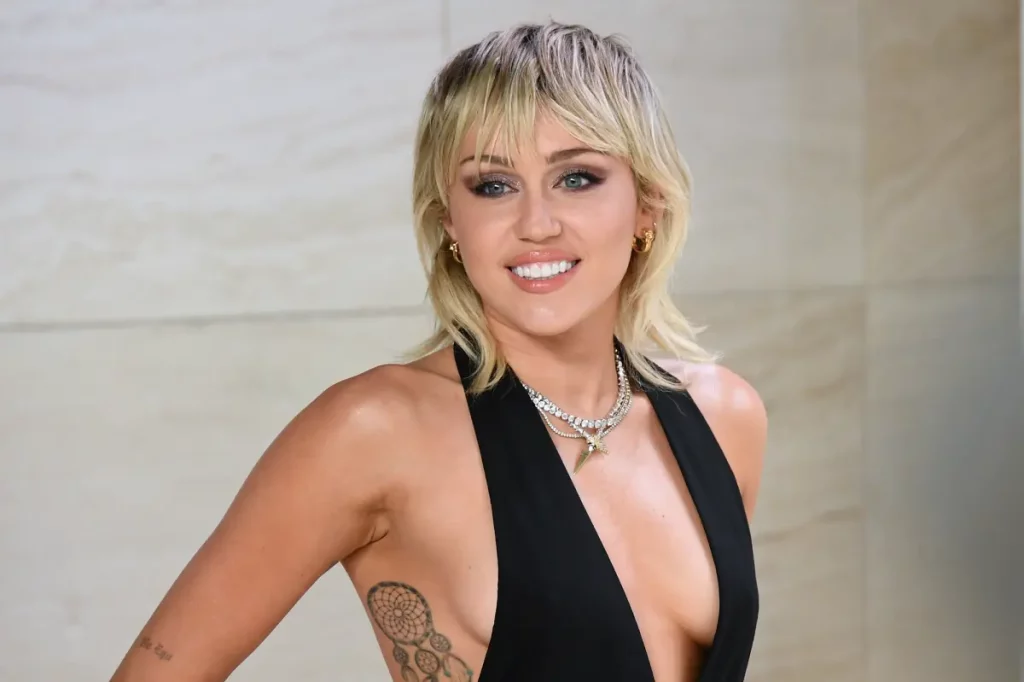Miley Cyrus has emerged as a musical chameleon, effortlessly transitioning from pop-rock to R&B and country-disco, leaving her mark across diverse genres. Her latest album, “Endless Summer Vacation,” has been a massive hit, and the release of the bonus track “Used to Be Young” further exemplifies her shape-shifting talents.
In the realm of pop music, artists who can seamlessly shift their image and sound while retaining their artistic essence have been celebrated across decades. Icons like David Bowie and Madonna come to mind, known for their transformative abilities. Miley Cyrus, however, has redefined this chameleon-like quality, aligning it with the evolving landscape of the 21st century. As the quintessential modern pop star, she capitalizes on the blurred boundaries of musical genres, catering to the era of eclectic Spotify playlists, where listeners are less constrained by traditional, genre-prescriptive radio playlists.
Miley Cyrus’s journey began 17 years ago when she portrayed a fictional pop star in the popular Disney series “Hannah Montana.” Since then, her musical repertoire has spanned from vibrant pop-rock to daring R&B, contemplative folk-pop to glitzy country-disco. At 30 years old, this multifaceted artist, actress, and cultural influencer is experiencing one of her most significant hits with “Flowers.” This breezy ode to self-love contains resonances of Gloria Gaynor’s “I Will Survive.” What makes “Flowers” stand out is the subtlety in both vocal delivery and musical arrangement. In a sun-dappled disco track that sat atop the Billboard Hot 100 chart for several weeks, she croons the line, “I can love me better than you can.” This track serves as the lead single from “Endless Summer Vacation,” her eighth studio album, released in March. It signals the start of yet another triumphant phase in her illustrious career. Moreover, “River,” the album’s remarkable second single, shares a sonic kinship with “Midnight Sky,” a Stevie Nicks-inspired hit from 2020.
Miley Cyrus’s evolution as a versatile artist reflects her ability to adapt and thrive in the ever-changing music landscape, cementing her status as a 21st-century pop icon.

New album Endless Summer Vacation's album cover shows her hanging from a trapeze – a typically bold image (Credit: Columbia Records)
Miley Cyrus’s song “Flowers” delivers a message of self-love with sincere authenticity, but her artistic journey also highlights her rare willingness to toy with her own image. In a 2019 episode of “Black Mirror,” she portrayed a fictional teen-pop star named Ashley O, a character that playfully nodded to her early alter ego, Hannah Montana, complete with a less-than-convincing wig. As “Ashley O,” she even reimagined Nine Inch Nails’ industrial rock hit, “Head Like a Hole,” as a cheerful club track called “On a Roll,” displaying her brilliant sense of humor.
Hugh McIntyre, a music journalist at Forbes, aptly describes Cyrus as a shapeshifter or chameleon in the music industry. He emphasizes her ability to consistently deliver high-quality music across a variety of genres. While she hasn’t tackled every genre, she has explored rock, pop, electronic music, and occasionally ventured into country and hip-hop. Cyrus’s track record is impressive, with no outright failures among her projects, which is a testament to her genre-hopping versatility.
Her latest album, “Endless Summer Vacation,” is another testament to Cyrus’s flair for reinvention. The album delves into the complexities of a past romantic relationship while effortlessly weaving together musical elements from genres in which she has previously excelled. From country on “Thousand Miles” to synth-pop on “Violet Chemistry” and psychedelic rock on “Rose Colored Lenses,” Cyrus’s artistry shines. “Jaded,” an alt-rock-flavored song, addresses an unnamed ex with lyrics like, “You’re not even willing to look at your part, you just jump in the car and head down to the bar ’til you’re blurry.” The album serves as her “love letter to LA,” and while this might sound unassuming, Cyrus’s penchant for grand gestures remains intact. The album cover, featuring her confidently hanging from a trapeze, underscores her commitment to authenticity and fearlessness in pushing boundaries.
Collaborations with renowned artists like Sia and Grammy-winning Americana and country singer Brandi Carlile further underscore Cyrus’s standing among her musical peers. Her diverse collaborative history spans from the psychedelic rock band The Flaming Lips to her godmother, country legend Dolly Parton.
At just 30 years old, Miley Cyrus has already become a seasoned industry veteran. Her journey began in 2001 with an uncredited guest appearance in “Doc,” a medical drama series starring her father, popular country singer Billy Ray Cyrus. At the age of 13, Cyrus became a global teen sensation through her iconic role in “Hannah Montana,” a Disney Channel series that ran for four seasons and spawned a spin-off film. In the show, she portrayed Miley Stewart, an apparently ordinary girl leading a double life as tween-pop sensation Hannah Montana. This clever premise allowed Cyrus to showcase both down-to-earth relatability and the charismatic appeal of a budding superstar. She transitioned seamlessly from Hannah Montana to Miley Cyrus without alienating her Disney Channel fanbase, signaling her ability to adapt and innovate from the outset. Her debut solo album, “Meet Miley Cyrus,” was released cautiously as a double album alongside the TV show’s season two soundtrack in 2007. The standout single, “See You Again,” hinted at her unique songwriting style with ear-catching lyrics. As she bid farewell to Hannah Montana with the show’s season finale in January 2011, Cyrus had already established herself as a successful pop star. Her hit songs, including “7 Things” (2008), “The Climb” (2009), and “Party in the USA” (2009), showcased her musical versatility across genres like pop-punk, country-flavored power ballads, and glossy midtempo pop. The latter song, co-written by British singer Jessie J, cleverly fed into her narrative as an ambitious Nashville girl trying to make it in the glamorous city of Los Angeles, despite having relocated there around four years earlier.

Cyrus shot to fame in her early teens with her starring role in Disney series Hannah Montana (Credit: Getty Images)
Over 13 years after reaching number two on the Billboard Hot 100, “Party in the USA” remains Cyrus’s most-streamed song, boasting 1.135 billion Spotify plays. Yet, with the benefit of hindsight, her 2010 single “Can’t Be Tamed” feels more prophetic. “I wanna fly, I wanna drive, I wanna go, I wanna be a part of something I don’t know,” she sings on this catchy electro-pop track. While ostensibly directed at a prospective partner, the lyrics also resonate as an expression of Cyrus’s restless creative spirit. In a 2020 interview on The Tonight Show Starring Jimmy Fallon, she confirmed that “Can’t Be Tamed” served as a harbinger of her transition, declaring, “I was already telling y’all that something was about to happen, that I wasn’t Hannah Montana.”
During her performance of “We Can’t Stop” with Robin Thicke at the 2013 MTV Video Music Awards (VMAs), Cyrus obliterated any remnants of her once-wholesome image. Twerking against Thicke while provocatively using a foam finger ignited widespread controversy. The foam finger’s inventor, Steve Chmelar, expressed disappointment at the unconventional use of this national symbol. Cyrus’s presence became polarizing during the “Bangerz” campaign, although some critics see the negative press coverage as collateral damage. “It was Miley’s moment to step out of the Disney spotlight and try something edgier and more adult, and that is always going to be received with some caution,” says music journalist Hugh McIntyre. He notes that Cyrus strategically supported her new, grown-up persona with the undeniable singles “We Can’t Stop” and “Wrecking Ball,” which became massive platinum-selling hits.
Music journalist El Hunt believes “Bangerz” made a substantial impact because it marked such a marked departure for Cyrus. However, it also ignited “predictable and empty outrage that always seems to follow female musicians, particularly when they sing about sexual empowerment.” In 2019, on the album’s sixth anniversary, Cyrus seemed to acknowledge this controversy in an Instagram post, stating, “Happy 6-year anniversary #Bangerz!!!! Here’s to 6 more years of pissing people off!” Nonetheless, it’s vital to recognize that the “Bangerz” era also generated valid criticism, particularly regarding Cyrus’s appropriation of aspects of black culture to emphasize her edgier image. She was scrutinized for embracing twerking and featuring women of color in her music videos. Cyrus defended herself, saying, “It’s mind-boggling to me that there was even a controversy around me having black dancers,” in an interview with Billboard in 2017. “That became a thing, where people said I was taking advantage of black culture, and with Mike [Will Made It] … that wasn’t true. Those were the dancers I liked!”
However, Hunt suggests that this criticism was heightened by Cyrus’s swift departure from the hip-hop-influenced sound of “Bangerz.” In fact, Cyrus’s post-“Bangerz” musical shift was dramatic and disarming, leading to the release of “Miley Cyrus & Her Dead Petz” in 2015. The album, partially created with psychedelic rock band The Flaming Lips, was a bold and unconventional departure, featuring 23 unapologetically un-radio-friendly tracks with titles like “Miley Tibetan Bowlzzz,” “Fweaky,” and “Something About Space Dude.” Even her record label was taken by surprise, as Cyrus announced its instant availability for free streaming during her hosting of that year’s VMAs. This unexpected pivot demonstrated her willingness to explore new sonic territories.
Despite her move away from hip-hop-inflected pop, discussions about Cyrus’s relationship with black culture did not entirely fade. While promoting her sixth album, “Younger Now,” a collection of folk and country tunes far removed from hip-hop, she expressed admiration for Kendrick Lamar’s rap hit “Humble” while criticizing the genre’s content, which she deemed misogynistic. These comments led her to distance herself from the hip-hop scene to some extent.

Cyrus' performance with Robin Thicke at the 2013 MTV Video Music Awards was one of the most talked about awards show moments of all time (Credit: Getty Images)
Miley Cyrus’s ever-evolving journey through the music industry has been marked by a series of transformations and controversies, capturing the essence of a true musical chameleon. Over her career, she has fearlessly navigated diverse genres and images, drawing both admiration and criticism. From pop sensation to hip-hop provocateur and rock maven, Cyrus’s versatility and willingness to reinvent herself have set her apart.
In 2019, she publicly apologized for remarks she made that had offended many in the hip-hop community, acknowledging her privilege in dipping in and out of musical scenes as it suited her creative direction. The apology demonstrated a growing awareness and sensitivity to the impact of her words and actions.
Cyrus has returned to hip-hop-infused pop with “She Is Coming,” an EP featuring collaborations with prominent artists like Wu-Tang Clan’s Ghostface Killah, singer-rapper Swae Lee, and drag icon RuPaul. Her continued support of the LGBTQ community, reflected in her openness about her own sexual fluidity and the establishment of The Happy Hippie Foundation, reinforces her position as a role model in this sphere.
In 2020, Cyrus showcased her rock prowess with the release of “Plastic Hearts.” The album featured collaborations with rock legends Joan Jett and Billy Idol, balancing her rock ambitions with pop sensibilities in hits like “Prisoner,” a collaboration with Dua Lipa.
Her latest offering, “Endless Summer Vacation,” is no exception to her pattern of surprising reinvention. It features a trippy psychedelic track, “Handstand,” co-written with experimental film director Harmony Korine. Cyrus’s genre-blurring ability aligns seamlessly with the ever-fluid state of contemporary music. As music journalist Hugh McIntyre notes, artists exploring different styles have become commonplace, reflecting the shifting landscape of the music industry.
Cyrus’s distinctive voice and songwriting style have remained recognizable and compelling throughout her journey. Her status as a true musical chameleon is undeniable. No matter which lane she chooses next, Miley Cyrus continues to captivate audiences and push the boundaries of musical expression. Her ability to adapt and transform represents the evolving landscape of modern music.
“Endless Summer Vacation” is now available, and as Miley herself proclaimed back in 2020, she’s an artist who simply “can’t be tamed.”
Note: This article was originally published in March 2023.

